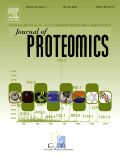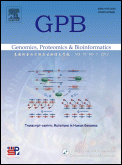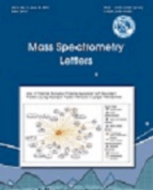
Journal of Proteomics
Scope & Guideline
Unlocking the secrets of protein interactions.
Introduction
Aims and Scopes
- Comprehensive Proteomic Analyses:
The journal focuses on comprehensive proteomic analyses utilizing advanced techniques such as mass spectrometry, enabling the identification and quantification of proteins in various biological samples. - Multi-Omics Approaches:
There is a significant emphasis on integrating proteomics with other omics technologies (genomics, metabolomics, etc.) to provide a holistic understanding of biological processes and disease mechanisms. - Disease Mechanisms and Biomarker Discovery:
Research published in the journal often aims at elucidating disease mechanisms and identifying potential biomarkers for various conditions, including cancers, metabolic disorders, and infectious diseases. - Innovative Methodologies:
The journal encourages the development and application of novel proteomic methodologies, including advanced labeling techniques, data-independent acquisition, and machine learning approaches for data analysis. - Functional Proteomics:
There is a strong focus on functional proteomics, exploring protein interactions, modifications, and their roles in cellular processes and disease pathology. - Comparative Proteomics:
The journal publishes studies that involve comparative analyses of proteomes across different species, conditions, or treatments, contributing to evolutionary biology and translational research.
Trending and Emerging
- Machine Learning and Computational Proteomics:
There is an increasing trend towards the application of machine learning and computational techniques in proteomics for data analysis, modeling, and predicting protein interactions and functions. - Clinical Applications and Translational Research:
Research aimed at clinical applications, particularly in biomarker discovery for diseases such as cancer, metabolic disorders, and neurological diseases, is on the rise, emphasizing the importance of proteomics in personalized medicine. - Environmental and Ecological Proteomics:
Emerging studies are focusing on the proteomic responses of organisms to environmental stressors, showcasing the application of proteomics in ecology and environmental science. - Proteomics in Regenerative Medicine and Stem Cell Research:
There is a growing interest in the role of proteomics in regenerative medicine and stem cell research, exploring how protein expression profiles can inform cell differentiation and tissue engineering. - Functional and Structural Proteomics:
The journal is seeing a rise in studies that explore the functional and structural aspects of proteins, including post-translational modifications and protein-protein interactions, which are crucial for understanding biological processes.
Declining or Waning
- Basic Protein Characterization:
There has been a noticeable decrease in studies focused solely on basic protein characterization without a clear application or connection to disease mechanisms or functional insights. - Single-Omics Studies:
Research solely focused on proteomics without integration with other omics approaches is becoming less common, as the trend moves toward multi-omics studies that provide more comprehensive insights. - Traditional Proteomic Techniques:
The reliance on traditional proteomic techniques, such as two-dimensional gel electrophoresis, appears to be waning in favor of more advanced and high-throughput methods, including mass spectrometry-based techniques. - Descriptive Studies:
There is a decline in purely descriptive studies that lack hypothesis-driven research or significant biological implications, as the field moves towards more application-oriented research.
Similar Journals

GENOMICS PROTEOMICS & BIOINFORMATICS
Unlocking the secrets of life through genomics and bioinformatics.GENOMICS PROTEOMICS & BIOINFORMATICS, published by Elsevier, stands at the forefront of cutting-edge research in the fields of genomics, proteomics, and bioinformatics. This esteemed journal, with an impact factor reflecting its significant influence, has embraced an Open Access model since its inception in 2003, ensuring that knowledge is freely accessible to a global community of researchers, professionals, and students. Based in China, it has been recognized for its exemplary contributions, achieving Q1 quartile rankings in major categories such as Biochemistry, Computational Mathematics, Genetics, and Molecular Biology as of 2023. Moreover, its commendable Scopus rankings position it among the top journals in its fields, with outstanding percentile performances that highlight its scholarly impact. As it continues to converge from 2003 to 2024, the journal aims to foster innovation and collaboration, making it an essential platform for disseminating vital insights and advancements in molecular life sciences.

Proteomes, published by MDPI since 2013, is a notable open access journal that occupies a critical place in the realms of Biochemistry, Clinical Biochemistry, Molecular Biology, and Structural Biology. Based in Switzerland, this journal not only promotes the dissemination of high-quality research pertaining to protein structures and functions but also emphasizes interdisciplinary approaches that bridge various fields of biomedical science. With a Category Quartile ranking of Q2 across multiple pertinent categories in 2023, Proteomes boasts a competitive impact within the scientific community, evidenced by its robust Scopus rankings. Researchers, professionals, and students are invited to explore a wealth of pioneering studies and reviews that are made freely accessible, aligning with global trends in open scientific communication. Whether contributing original research or seeking to expand their knowledge, the journal serves as an invaluable resource for anyone engaged in the evolving landscape of proteomics.

BIOCHEMISTRY-MOSCOW
Advancing the Frontiers of Biochemical ResearchBIOCHEMISTRY-MOSCOW is a distinguished academic journal published by MAIK NAUKA/INTERPERIODICA/SPRINGER, focusing on pivotal research in the fields of biochemistry, biophysics, geriatrics, and broader medical sciences. Established in 1972, the journal has a rich history of disseminating critical findings and innovative studies, making significant contributions to the advancement of biochemical knowledge and applications. With its Q2 ranking in various categories including biochemistry and gerontology, the journal commands respect within the scientific community, offering a reputable platform for both established researchers and emerging scholars alike. Although traditionally not an open-access journal, it provides a wealth of information accessible through institutional subscriptions, ensuring the latest advancements reach a global audience. The journal aims to enhance understanding of biochemical processes and their implications for human health, and its commitment to high-quality peer-reviewed content has established it as a vital resource for those invested in the life sciences.

Comparative Biochemistry and Physiology D-Genomics & Proteomics
Advancing Understanding Through Comparative Insights in Molecular BiologyComparative Biochemistry and Physiology D-Genomics & Proteomics, published by Elsevier Science Inc, is a premier journal in the realm of molecular biology and comparative physiology, with a focus on genomic and proteomic sciences. Recognized for its high-impact contributions, it holds a Q1 ranking in Animal Science and Zoology and was established with the vision of bridging gaps in our understanding of biological systems through experimental and comparative approaches. With an impressive Scopus ranking, this journal not only ranks among the top 12% in Animal Science and Zoology but also demonstrates commendable standings across various categories including Aquatic Science and Molecular Biology. The journal’s commitment to disseminating high-quality research makes it an essential resource for researchers, professionals, and students alike, allowing them to access critical studies that influence advancements in genomics and proteomics. While it operates under a traditional subscription model, its impactful findings are crucial for those aiming to enrich their knowledge and research capabilities in these pivotal scientific fields. Join us in exploring the transformative insights and developments that this esteemed journal has to offer for the study of genomics and proteomics.

FEBS LETTERS
Connecting Researchers Through Groundbreaking InsightsFEBS LETTERS, published by Wiley, is a prestigious journal that has firmly established its place in the fields of biochemistry, biophysics, genetics, molecular biology, cell biology, and structural biology. With an esteemed history dating back to 1968, this journal continues to be a vital resource for researchers and professionals involved in the biological sciences. It boasts impressive quartile rankings, including Q1 statuses in several categories such as Biochemistry and Genetics, reflecting its high impact factor and significant contribution to scientific discourse. FEBS LETTERS provides a platform for innovative findings and critical reviews, fostering the exchange of knowledge and ideas within the scientific community. Although it operates under a subscription model, the journal ensures broad dissemination of groundbreaking research through its rigorous peer-review process. The vibrant discussions encouraged by articles published in FEBS LETTERS aim to inspire current and future generations of scientists to push the boundaries of biological understanding, making it an indispensable resource for anyone dedicated to advancing their knowledge in these dynamic fields.

Molecular Omics
Unlocking the Secrets of Molecular MechanismsMolecular Omics is a premier, peer-reviewed journal published by the Royal Society of Chemistry, focusing on the interdisciplinary field of molecular biology with significant implications for biochemistry and genetics. With an E-ISSN of 2515-4184, this journal has been dedicated to disseminating high-quality research since its inception in 2018, maintaining an impressive trajectory in academic contributions until 2024. Currently, it holds a Q2 quartile ranking in both Biochemistry and Genetics, alongside a Q3 ranking in Molecular Biology for 2023, highlighting its relevance and influence in these domains. The journal is accessible as an open access publication, promoting the widespread dissemination of groundbreaking research. As part of a vibrant academic community, Molecular Omics aims to bridge fundamental and applied science, appealing to researchers, professionals, and students eager to expand their knowledge on molecular mechanisms and technologies that shape the future of biological research.

All Life
Bridging Disciplines for a Deeper Understanding of LifeAll Life is a distinguished academic journal published by TAYLOR & FRANCIS LTD, based in the United Kingdom, focusing on the interdisciplinary realms of agricultural and biological sciences, biochemistry, genetics, and neuroscience. With the ISSN 2689-5293 and E-ISSN 2689-5307, this open-access journal aims to disseminate high-quality research from 2020 to 2024, facilitating a wider reach and impact across various fields. Notably, it holds a Q3 ranking in both Agricultural and Biological Sciences, as well as Biochemistry, Genetics and Molecular Biology, and a Q4 ranking in Neuroscience, reflecting its growing presence in these disciplines. All Life aims to foster collaboration among researchers, professionals, and students, encouraging innovative approaches in understanding life sciences. By delivering timely insights and thought-provoking discussions, the journal plays a crucial role in advancing knowledge and promoting interdisciplinary dialogue in the evolving landscape of life sciences research.

Mass Spectrometry Letters
Exploring Innovative Frontiers in Analytical Chemistry.Mass Spectrometry Letters is a pioneering open-access journal published by the Korean Society for Mass Spectrometry, specializing in the diverse fields of analytical chemistry, biochemistry, and spectroscopy. Established in 2010, this journal aims to disseminate groundbreaking research and advancements in mass spectrometry and its applications across various scientific domains. Though currently categorized in the Q4 quartile in key analytical fields, Mass Spectrometry Letters serves as an essential platform for researchers, professionals, and students to share innovative methodologies, emerging trends, and practical applications of mass spectrometry, thus fostering collaboration and advancing knowledge in the scientific community. With a commitment to open access, articles published since 2010 are readily available, enabling widespread distribution and engagement within the international research community. Located in Daejeon, South Korea, and actively converging research through 2024, the journal holds the potential to grow its impact and relevance within the dynamic landscape of mass spectrometry.

Doklady Biochemistry and Biophysics
Transforming Research into Understanding in Biochemistry and BiophysicsDoklady Biochemistry and Biophysics is a vital resource for the advancement of knowledge in the fields of biochemistry and biophysics, published by MAIK NAUKA/INTERPERIODICA/SPRINGER. Featuring an ISSN of 1607-6729 and an E-ISSN of 1608-3091, this journal plays a critical role in disseminating research findings and fostering scholarly discourse. Despite its recent ranking in the Q4 quartile for biochemistry and biophysics in 2023, it serves as an essential platform for researchers exploring these intertwined disciplines. The journal’s scope encompasses a wide variety of topics, enhancing the understanding of biochemical processes and physical principles in biological systems. With converged years of publication from 2001 to 2024, it stands as a continual source of knowledge for its readers, who include researchers, professionals, and students alike. While the journal currently does not offer open access options, its contributions remain significant within the scholarly community, illustrated by its competitive Scopus rankings across related fields.

MOLECULAR & CELLULAR PROTEOMICS
Exploring the intersection of biochemistry and analytical chemistry.MOLECULAR & CELLULAR PROTEOMICS, published by Elsevier, stands as a premier journal in the fields of Biochemistry, Analytical Chemistry, and Molecular Biology, with a distinguished Q1 ranking reflecting its high impact and contribution to the scientific community. Established in 2002, this journal has consistently provided a platform for the latest research in protein science, merging molecular biology with advanced analytical techniques. With impressive Scopus rankings—41st in Biochemistry and 16th in Analytical Chemistry—it caters to an audience of researchers, professionals, and students eager to explore cutting-edge developments in proteomics. Although currently not designated as open access, the journal aims to foster knowledge dissemination through accessible research content. As it continues to evolve until 2024, MOLECULAR & CELLULAR PROTEOMICS is essential for anyone passionately engaged in the ever-expanding field of proteomics.